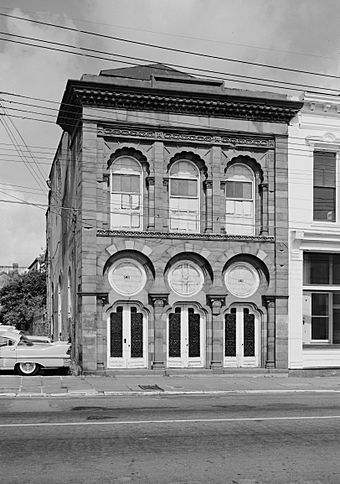Farmers' and Exchange Bank facts for kids
|
Farmers' and Exchange Bank
|
|
|
U.S. National Historic Landmark District
Contributing Property |
|

Farmers' and Exchange Bank
|
|
| Location | 141 E. Bay St., Charleston, South Carolina |
|---|---|
| Built | 1853–54 |
| Architect | Edward C. Jones; Francis D. Lee |
| Architectural style | Moorish Revival, Exotic Revival |
| Part of | Charleston Historic District (ID66000964) |
| NRHP reference No. | 73001685 |
Quick facts for kids Significant dates |
|
| Added to NRHP | November 7, 1973 |
| Designated NHL | November 7, 1973 |
| Designated NHLDCP | October 9, 1960 |
The Farmers' and Exchange Bank is a super cool old building in Charleston, South Carolina. It was built a long time ago, between 1853 and 1854. What makes it special is its amazing design. It has a unique style called Moorish Revival, which looks like buildings from North Africa and the Middle East. This style is very rare to see in the United States!
You can easily spot this building because of its fancy carvings called muqarnas. These carvings look a bit like honeycombs and are common in Persian and North African buildings. The bank also has big arched windows and a striking red stone front. Because of its special look, it was named a National Historic Landmark in 1973. This means it's a very important historical place!
Contents
What Makes This Building Special?
The Farmers' and Exchange Bank is located on East Bay Street in the historic part of Charleston. It's a two-story building made of brick and different shades of brown stone. The outside is covered with a smooth finish called stucco.
Cool Architectural Details
The front of the building has three large sections. Each section has a tall, arched opening with those unique Moorish features.
- The first floor has openings with a curvy shape. Above these, you'll see round windows. The doors are also super detailed with intricate carvings.
- The second-floor openings are similar. Their upper round parts have a wavy, scalloped edge. The arches are filled with big windows made of many small glass panes.
Who Designed This Unique Building?
The Farmers' and Exchange Bank was designed by two architects from Charleston. Their names were Edward C. Jones and Francis D. Lee. They finished building it in 1854.
Inspiration Behind the Design
Historians think the architects got their ideas from books. They probably looked at pictures of Moorish buildings in a famous book. This book was called The Alhambra by Washington Irving. It was published around the same time the bank was being built.
For a while, people thought the design might have been inspired by British architecture. Specifically, they thought it looked like buildings from the Regency period in Great Britain. Some buildings from that time, like the Royal Pavilion in Brighton, had an "Indian" influence. However, experts now believe the architects probably didn't see those British buildings.
Saving a Piece of History
In the early 1970s, there was a plan to tear down this amazing building. But a kind banker from Charleston, Hugh Lane Sr., stepped in. He gave $50,000 to help restore it. Thanks to him, this unique piece of history was saved for everyone to enjoy today!



